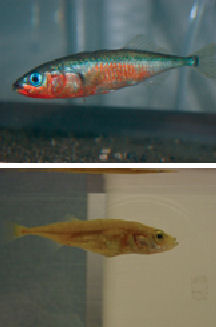Known largely as a component of rocket fuel, perchlorate is a pollutant that often turns up in soil and water. In dozens of studies, it has perturbed thyroid-hormone concentrations, which can affect growth and neurological development. Data from fish now indicate that perchlorate can also disrupt sexual development.

Some of the changes were so dramatic that scientists initially mistook female fish for males. Several females displayed male-courtship behavior and produced sperm.
Richard R. Bernhardt of the University of Alaska in Anchorage and his colleagues focused on threespine sticklebacks (Gasterosteus aculeatus), a tiny marine species. For 3 weeks, the researchers incubated wild-captured adults in clean water or in water treated with 30, 60, or 100 parts per million (ppm) perchlorate. The adults spawned during that period.
Each group’s offspring were then raised to sexual maturity in similarly treated or untreated water. At spawning age, 10 apparent males per treatment group were each given their own aquariums. Once a day, each male received a 10-minute visit from an egg-swollen female in the same treatment group.
The first sign of something amiss: Among perchlorate-exposed fish, many would-be dads lacked the electric-blue and red coloration that normally signals readiness to spawn. Most of these fish didn’t exhibit typical reproductive behaviors, such as nest building, and many ignored prospective mates. Among clean-water males, 80 percent spawned. As the perchlorate concentration climbed from 30 to 100 ppm, successful spawning fell from 50 percent to zero.
Eventually, the bellies of three apparent males began swelling with eggs. They proved to be hermaphroditic females, bearing both fertile eggs and fertile sperm.
The perchlorate-exposed true males developed unusually long testes.
Last January, the Environmental Protection Agency suggested limiting perchlorate contamination in natural bodies of water to 24.5 parts per billion. The concentrations used in the new study were at least 1,000 times that limit.
However, these doses are still environmentally relevant, argue aquatic toxicologist Bernhardt and his colleagues in the August Environmental Toxicology and Chemistry. They say that the test concentrations are similar to or less than those at several contaminated U.S. sites.
The “big surprise” was that perchlorate could produce hermaphroditic females and males with superlarge testes, says ecotoxicologist Gerald T. Ankley of EPA’s Mid-Continent Ecology Division in Duluth, Minn. Clearly, that’s “not something you would have anticipated [from] the way we think perchlorate works,” he adds.
All the changes observed suggest that perchlorate “is acting like an androgen,” or male-sex hormone, notes fish physiologist Ann Cheek of the University of Texas Health Science Center at Houston. Confirming this would require cellular analyses of testes and thyroid tissue.
Christopher W. Theodorakis of Southern Illinois University in Edwardsville argues that the “intriguing” masculinization may instead point to a new role for thyroid hormones—preservation of reproductive function.
“This paper may be telling us there’s more to perchlorate—and its effects on the thyroid—than we’d realized,” agrees R. Thomas Zoeller, a thyroid endocrinologist at the University of Massachusetts in Amherst. That “could be pretty profound,” he says.






